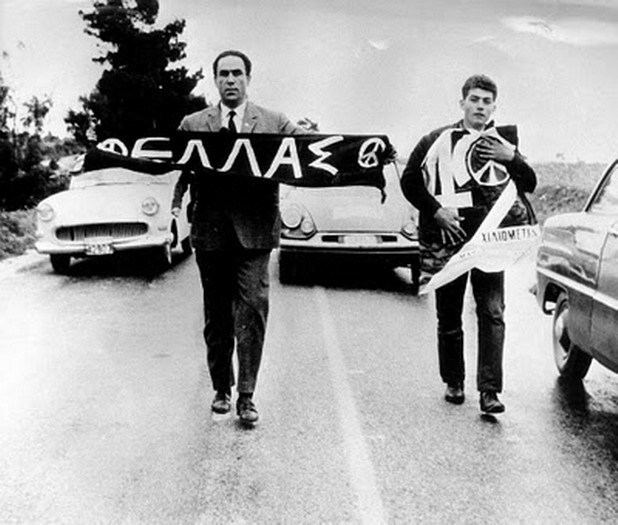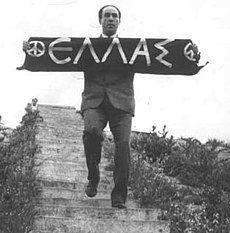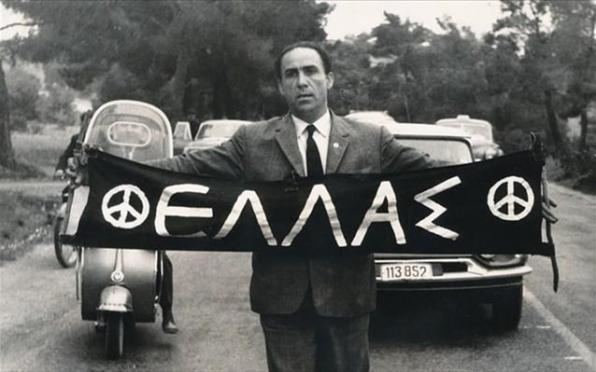Name Grigoris Lambrakis | Occupation Gynecologist | |
 | ||
Born April 3, 1912Kerasitsa, Arcadia, Greece ( 1912-04-03 ) Children Grogoris Lambrakis, Theodoros Lambrakis | ||
Good Thinking, Dr. Grigoris Lambrakis, Greece, Nuclear Weapons
Grigoris Lambrakis (Greek: Γρηγόρης Λαμπράκης; 3 April 1912 – 27 May 1963) was a Greek politician, physician, track and field athlete, and member of the faculty of the School of Medicine at the University of Athens. A member of the Greek resistance to Axis rule during WWII, he later became a prominent anti-war activist. His assassination by right-wing zealots provoked mass protests and led to a political crisis.
Contents
- Good Thinking Dr Grigoris Lambrakis Greece Nuclear Weapons
- Early life
- Postwar activism
- Assassination
- Events following his assassination
- Legacy
- References

Early life

Lambrakis was born in the village of Kerasitsa in the district of Tegea (Arcadia, the Peloponnese). After finishing high school in his home town, he moved to Athens to enter the School of Medicine at the University of Athens.

Lambrakis was a champion athlete throughout his life. He held the Greek record for long jump for twenty-three years (1936–1959). He also earned several gold medals in the Balkan Games, which took place annually, featuring competitors from Greece, Yugoslavia, Bulgaria, Romania, and Turkey.

During the Axis occupation of Greece during World War II (1941–44), Lambrakis participated actively in the Greek Resistance. In 1943 he set up the Union of Greek Athletes (Ένωση των Ελλήνων Αθλητών, Enosi ton Ellínon Athlitón) and organized regular competitions. He used the revenue from these games to fund public food-banks for the starving population.
Postwar activism
After World War II, Lambrakis completed his medical studies and worked as a lecturer in the Department of gynaecology. He continued to help the poor by running a small private clinic for patients who were unable to afford medical care.
While not a Communist, Lambrakis' political and ideological orientation leaned towards the left. He was actively involved in the pacifist movement of his time, which voiced strong opposition to the Vietnam War. Lambrakis acted politically from within the United Democratic Left (Greek: Ενιαία Δημοκρατική Αριστερά, ΕΔΑ/Eniéa Dimokratikí Aristerá, EDA), the only legal left-wing political party in the country after the Greek Civil War of 1946–1949 and until the fall of the Greek military junta of 1967-1974. He was elected to the Hellenic Parliament in the Greek legislative election, 1961 as a Piraeus MP.
That same year (1961), under his initiative, the Commission for International Détente and Peace (Eπιτροπή για την Διεθνή Ύφεση και Ειρήνη — Epitropí gia ti Diethní Ýfesi ke Iríni — EDYE) was established in Greece. In his capacity as Vice President of EDYE, Lambrakis participated in international pacifist meetings and demonstrations despite frequent threats against his life. EDYE was an organization set up by EDA which while not officially aligned to the World Council of Peace broadly supported its anti-capitalist and anti-imperialist position. EDA had ceded Lambrakis full freedom to represent the Commission and he soon emerged as its most articulate and determined leader. On April 21, 1963, the pacifist movement in Greece organized the First Pacifist Rally from Marathon to Athens. The police intervened, banned the rally and arrested many demonstrators (Mikis Theodorakis among them). Lambrakis, protected by his parliamentary immunity, marched alone and arrived at the end of the rally holding the banner with the peace symbol (photo), the one that he had previously held up during the Aldermaston rally in the United Kingdom while he was protesting near the Atomic Weapons Research Establishment (AWRE). Soon afterward, he too was arrested by the police.
Assassination
On May 22, 1963, shortly after he had delivered the keynote speech at an anti-war meeting in Thessaloniki, two far-right extremists, Emannouel Emannouilides and Spyros Gotzamanis, driving a three-wheeled vehicle, struck Lambrakis with a club over the head in plain view of a large number of people and (allegedly) some police officers. He suffered brain injuries and died in the hospital five days later, on May 27. The two men were arrested because of the reaction of a by-stander (Manolis Hatziapostolou, nicknamed Tiger) who jumped on their vehicle and fought with them.
Events following his assassination
The next day, in Athens, his funeral became a massive demonstration. More than 500,000 people rallied to protest against the right-wing government and the Royal Court, seen by many to support the activities of the right-wing extremists. The assassination of Lambrakis initiated an enormous popular reaction, and soon after, investigator Christos Sartzetakis, district attorney Nikos Athanasopoulos and Attorney General P. Delaportas uncovered connections of the police and army, including the Gendarmerie commander for Northern Greece, Konstantinos Mitsou, to far-right extremists. The men lost their jobs during the military dictatorship of 1967. Christos Sartzetakis was also imprisoned for a year during the dictatorship. Sartzetakis became a symbol of integrity for his handling of the investigation.
The events that followed the assassination of Lambrakis led to rapid political developments. Prime Minister Konstantinos Karamanlis resigned and left for Paris in July 1963. Soon thereafter, thousands of Greek youth founded a new political organisation called the Lambrakis Democratic Youth (Δημοκρατική Νεολαία Λαμπράκη, Demokratiki Neoléa Lambráki). Mikis Theodorakis, one of Lambrakis' friends and fellow activists, was elected its first president. This leftist political organisation played a decisive role in Greece's progressive movement of the 1960s. In 1966 a 'Greek Demokratic Youth of Australia Lambrakis' was formed in all capitals of the States of Australia by young Greek workers and students.
Legacy
The life and death of Grigoris Lambrakis inspired the author Vassilis Vassilikos to write the political novel "Z". The title stands for the first letter of the Greek word "Zi" ("[He] Lives!"), a popular graffito which began to appear on the walls of the buildings of the Greek cities in the 1960s, illustrating the growing protest against the conditions that led to the assassination of Lambrakis. In 1969, the Greek-French film director Costa-Gavras (Κώστας Γαβράς) made the film Z, which was a great success. Yves Montand starred as Lambrakis, Jean-Louis Trintignant as investigator Sartzetakis and Irene Papas as Lambrakis' widow.
Mikis Theodorakis in 1962 presented his work Omiros (Hostage), a music score for a Greek performance of The Hostage (play) by Brendan Behan. The piece to yelasto paidi (the smiling kid) was considered to be a tribute to Lambrakis.
Lambrakis remained in the hearts of the Greek people as a national symbol of democracy, representing the struggle against political repression, Royal Court scandal, and international dependence. After the fall of the military dictatorship in 1974, numerous places, including a football stadium in Kallithea and streets and squares throughout the country, have been named in honor of Grigoris Lambrakis.
The Marathon Peace Rally became an annual event in Lambrakis' memory. Also, the Athens Classic Marathon is run in memory of Grigoris Lambrakis every November.
